Clinical Reasoning Cycle: Mrs. Kennedy's Pneumonia Case Study
VerifiedAdded on 2021/02/21
|7
|2257
|287
Case Study
AI Summary
This assignment presents a detailed analysis of a case study involving Mrs. Carole Kennedy, a 56-year-old patient admitted for pneumonia. The analysis employs the clinical reasoning cycle to evaluate changes in Mrs. Kennedy's clinical presentation, focusing on her subjective and objective data, including chest pain, shortness of breath, and vital signs. The study emphasizes the impact of her medical history, including ischemic heart disease and hypertension, on her current condition. The assignment critically examines nursing priorities of care, particularly utilizing the ABC (Airway, Breathing, Circulation) approach to identify and address key issues such as breathing difficulties and chest pain. It proposes interventions like oxygen therapy and drug interventions to manage symptoms and improve SpO2 levels. Furthermore, the assignment discusses the psychosocial issues affecting Mrs. Kennedy, such as her living situation and financial concerns, and their impact on her health. The conclusion summarizes the application of the clinical reasoning cycle in understanding the patient's condition and determining appropriate nursing interventions based on the analysis of her case.
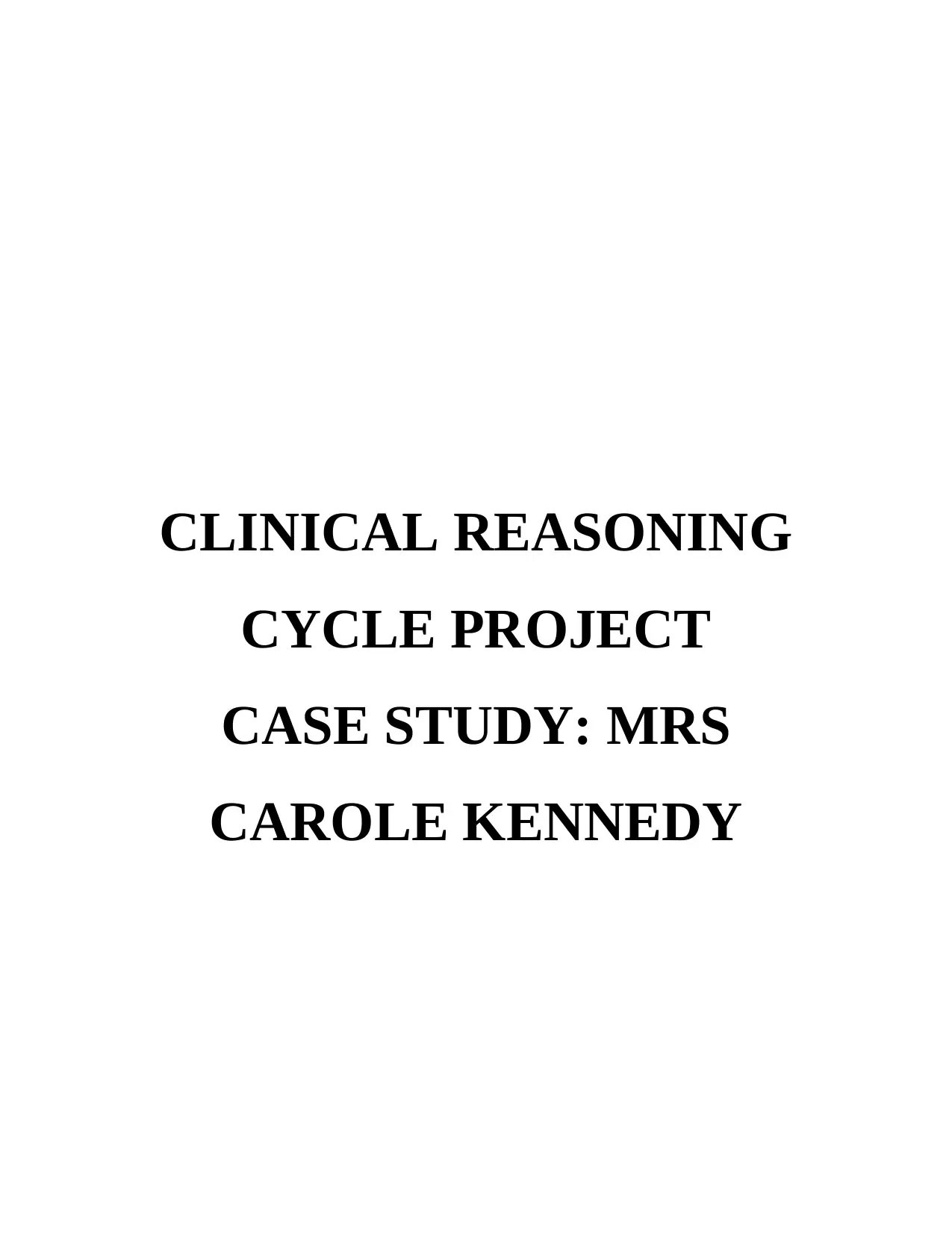
CLINICAL REASONING
CYCLE PROJECT
CASE STUDY: MRS
CAROLE KENNEDY
CYCLE PROJECT
CASE STUDY: MRS
CAROLE KENNEDY
Paraphrase This Document
Need a fresh take? Get an instant paraphrase of this document with our AI Paraphraser
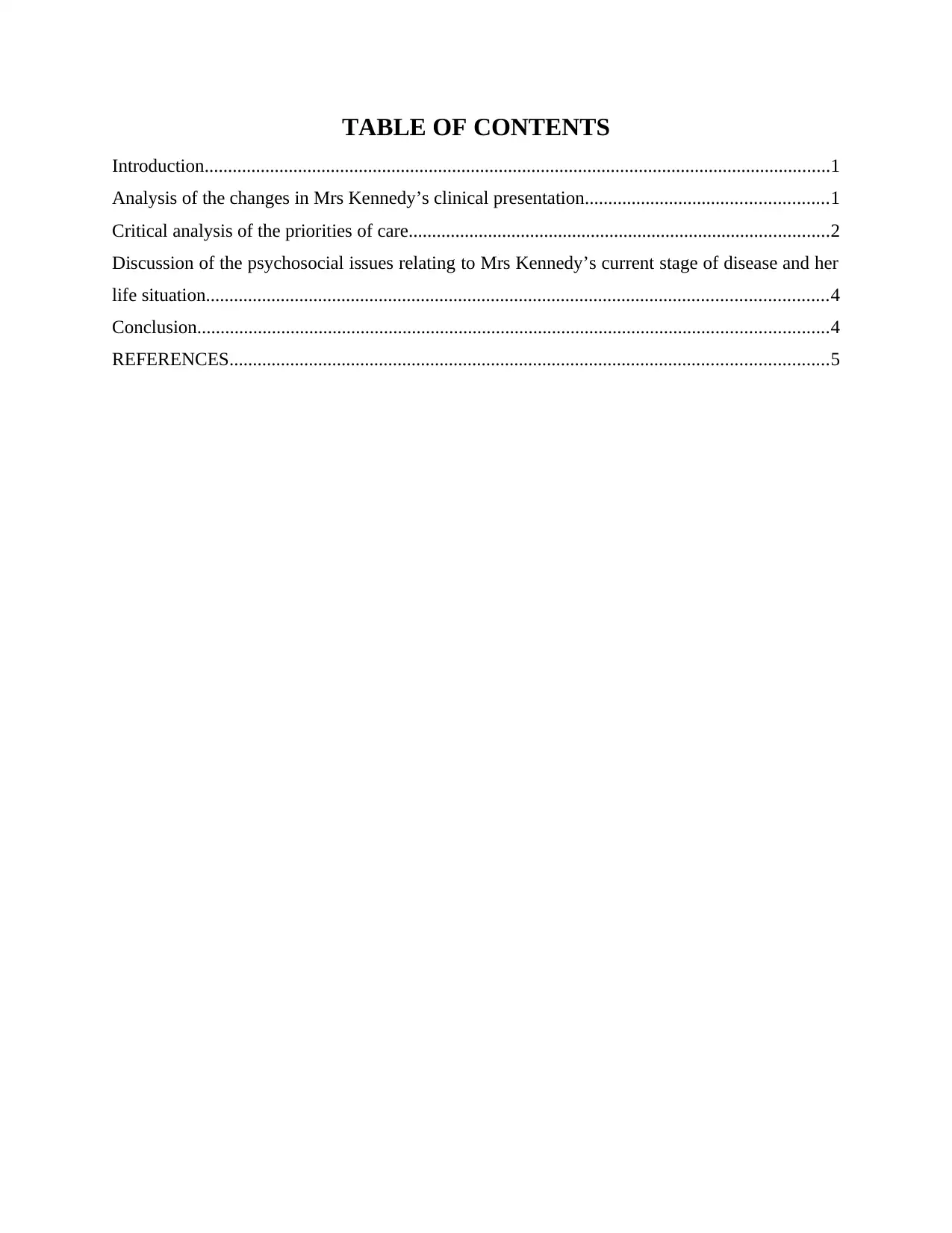
TABLE OF CONTENTS
Introduction......................................................................................................................................1
Analysis of the changes in Mrs Kennedy’s clinical presentation....................................................1
Critical analysis of the priorities of care..........................................................................................2
Discussion of the psychosocial issues relating to Mrs Kennedy’s current stage of disease and her
life situation.....................................................................................................................................4
Conclusion.......................................................................................................................................4
REFERENCES................................................................................................................................5
Introduction......................................................................................................................................1
Analysis of the changes in Mrs Kennedy’s clinical presentation....................................................1
Critical analysis of the priorities of care..........................................................................................2
Discussion of the psychosocial issues relating to Mrs Kennedy’s current stage of disease and her
life situation.....................................................................................................................................4
Conclusion.......................................................................................................................................4
REFERENCES................................................................................................................................5
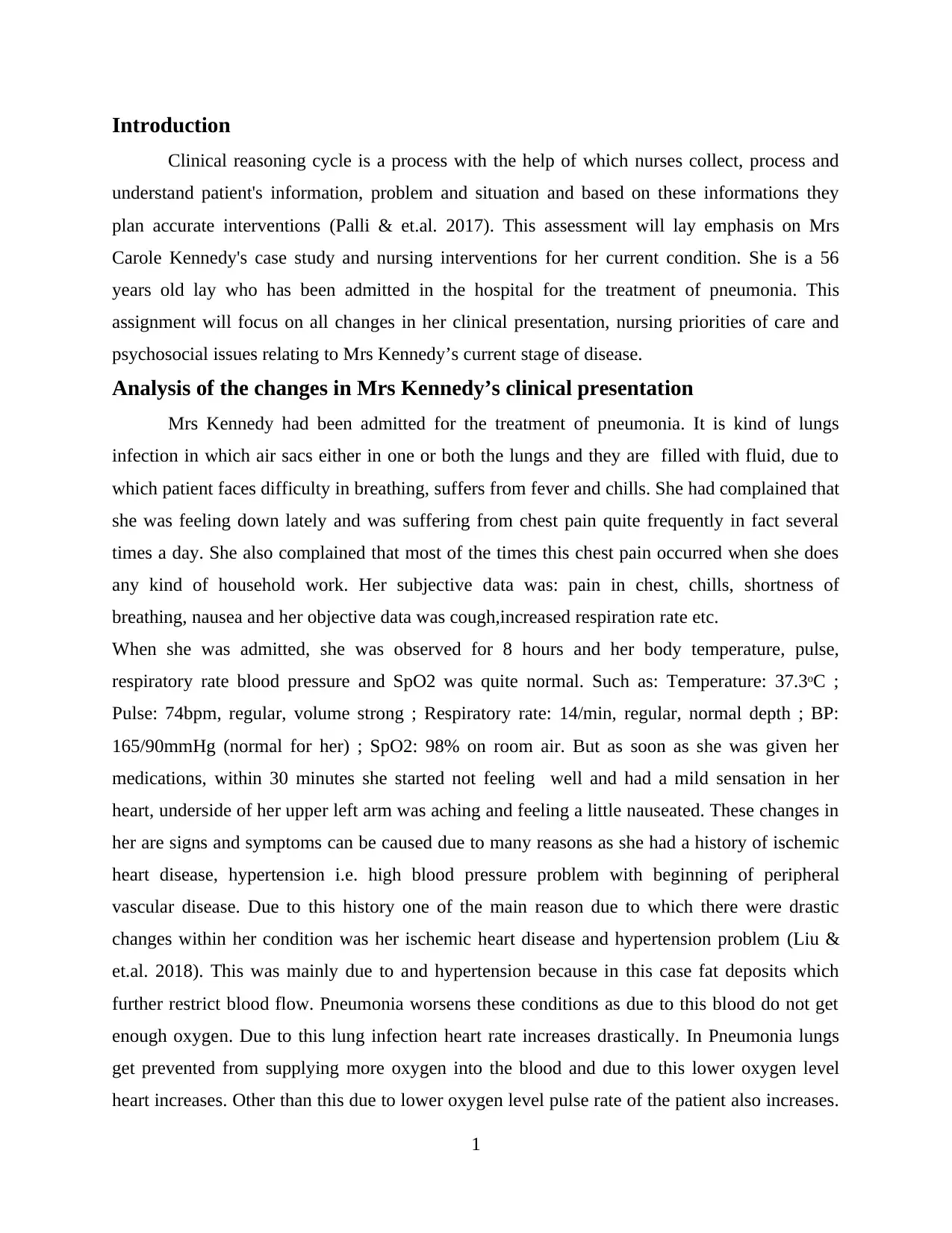
Introduction
Clinical reasoning cycle is a process with the help of which nurses collect, process and
understand patient's information, problem and situation and based on these informations they
plan accurate interventions (Palli & et.al. 2017). This assessment will lay emphasis on Mrs
Carole Kennedy's case study and nursing interventions for her current condition. She is a 56
years old lay who has been admitted in the hospital for the treatment of pneumonia. This
assignment will focus on all changes in her clinical presentation, nursing priorities of care and
psychosocial issues relating to Mrs Kennedy’s current stage of disease.
Analysis of the changes in Mrs Kennedy’s clinical presentation
Mrs Kennedy had been admitted for the treatment of pneumonia. It is kind of lungs
infection in which air sacs either in one or both the lungs and they are filled with fluid, due to
which patient faces difficulty in breathing, suffers from fever and chills. She had complained that
she was feeling down lately and was suffering from chest pain quite frequently in fact several
times a day. She also complained that most of the times this chest pain occurred when she does
any kind of household work. Her subjective data was: pain in chest, chills, shortness of
breathing, nausea and her objective data was cough,increased respiration rate etc.
When she was admitted, she was observed for 8 hours and her body temperature, pulse,
respiratory rate blood pressure and SpO2 was quite normal. Such as: Temperature: 37.3ᵒC ;
Pulse: 74bpm, regular, volume strong ; Respiratory rate: 14/min, regular, normal depth ; BP:
165/90mmHg (normal for her) ; SpO2: 98% on room air. But as soon as she was given her
medications, within 30 minutes she started not feeling well and had a mild sensation in her
heart, underside of her upper left arm was aching and feeling a little nauseated. These changes in
her are signs and symptoms can be caused due to many reasons as she had a history of ischemic
heart disease, hypertension i.e. high blood pressure problem with beginning of peripheral
vascular disease. Due to this history one of the main reason due to which there were drastic
changes within her condition was her ischemic heart disease and hypertension problem (Liu &
et.al. 2018). This was mainly due to and hypertension because in this case fat deposits which
further restrict blood flow. Pneumonia worsens these conditions as due to this blood do not get
enough oxygen. Due to this lung infection heart rate increases drastically. In Pneumonia lungs
get prevented from supplying more oxygen into the blood and due to this lower oxygen level
heart increases. Other than this due to lower oxygen level pulse rate of the patient also increases.
1
Clinical reasoning cycle is a process with the help of which nurses collect, process and
understand patient's information, problem and situation and based on these informations they
plan accurate interventions (Palli & et.al. 2017). This assessment will lay emphasis on Mrs
Carole Kennedy's case study and nursing interventions for her current condition. She is a 56
years old lay who has been admitted in the hospital for the treatment of pneumonia. This
assignment will focus on all changes in her clinical presentation, nursing priorities of care and
psychosocial issues relating to Mrs Kennedy’s current stage of disease.
Analysis of the changes in Mrs Kennedy’s clinical presentation
Mrs Kennedy had been admitted for the treatment of pneumonia. It is kind of lungs
infection in which air sacs either in one or both the lungs and they are filled with fluid, due to
which patient faces difficulty in breathing, suffers from fever and chills. She had complained that
she was feeling down lately and was suffering from chest pain quite frequently in fact several
times a day. She also complained that most of the times this chest pain occurred when she does
any kind of household work. Her subjective data was: pain in chest, chills, shortness of
breathing, nausea and her objective data was cough,increased respiration rate etc.
When she was admitted, she was observed for 8 hours and her body temperature, pulse,
respiratory rate blood pressure and SpO2 was quite normal. Such as: Temperature: 37.3ᵒC ;
Pulse: 74bpm, regular, volume strong ; Respiratory rate: 14/min, regular, normal depth ; BP:
165/90mmHg (normal for her) ; SpO2: 98% on room air. But as soon as she was given her
medications, within 30 minutes she started not feeling well and had a mild sensation in her
heart, underside of her upper left arm was aching and feeling a little nauseated. These changes in
her are signs and symptoms can be caused due to many reasons as she had a history of ischemic
heart disease, hypertension i.e. high blood pressure problem with beginning of peripheral
vascular disease. Due to this history one of the main reason due to which there were drastic
changes within her condition was her ischemic heart disease and hypertension problem (Liu &
et.al. 2018). This was mainly due to and hypertension because in this case fat deposits which
further restrict blood flow. Pneumonia worsens these conditions as due to this blood do not get
enough oxygen. Due to this lung infection heart rate increases drastically. In Pneumonia lungs
get prevented from supplying more oxygen into the blood and due to this lower oxygen level
heart increases. Other than this due to lower oxygen level pulse rate of the patient also increases.
1
⊘ This is a preview!⊘
Do you want full access?
Subscribe today to unlock all pages.

Trusted by 1+ million students worldwide
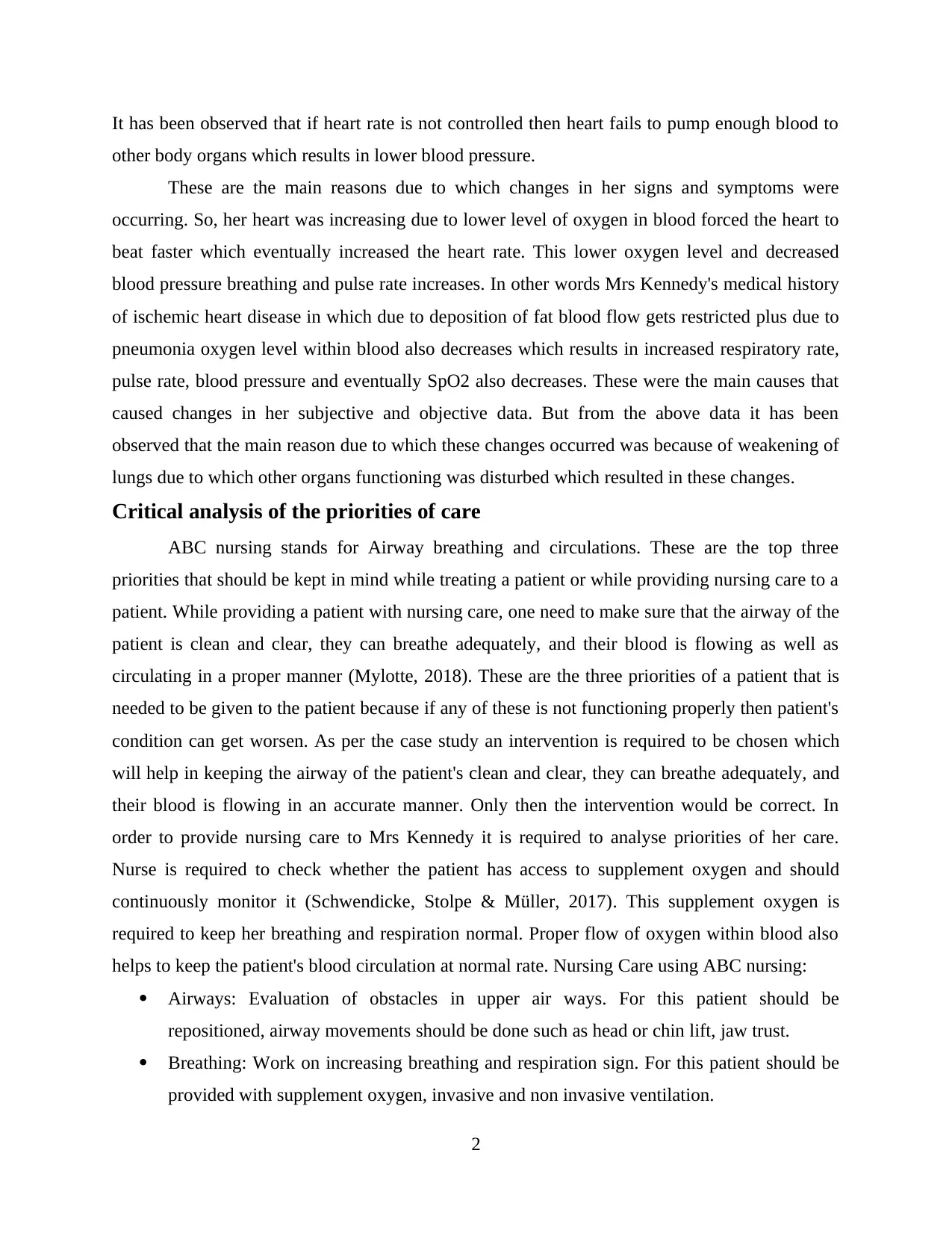
It has been observed that if heart rate is not controlled then heart fails to pump enough blood to
other body organs which results in lower blood pressure.
These are the main reasons due to which changes in her signs and symptoms were
occurring. So, her heart was increasing due to lower level of oxygen in blood forced the heart to
beat faster which eventually increased the heart rate. This lower oxygen level and decreased
blood pressure breathing and pulse rate increases. In other words Mrs Kennedy's medical history
of ischemic heart disease in which due to deposition of fat blood flow gets restricted plus due to
pneumonia oxygen level within blood also decreases which results in increased respiratory rate,
pulse rate, blood pressure and eventually SpO2 also decreases. These were the main causes that
caused changes in her subjective and objective data. But from the above data it has been
observed that the main reason due to which these changes occurred was because of weakening of
lungs due to which other organs functioning was disturbed which resulted in these changes.
Critical analysis of the priorities of care
ABC nursing stands for Airway breathing and circulations. These are the top three
priorities that should be kept in mind while treating a patient or while providing nursing care to a
patient. While providing a patient with nursing care, one need to make sure that the airway of the
patient is clean and clear, they can breathe adequately, and their blood is flowing as well as
circulating in a proper manner (Mylotte, 2018). These are the three priorities of a patient that is
needed to be given to the patient because if any of these is not functioning properly then patient's
condition can get worsen. As per the case study an intervention is required to be chosen which
will help in keeping the airway of the patient's clean and clear, they can breathe adequately, and
their blood is flowing in an accurate manner. Only then the intervention would be correct. In
order to provide nursing care to Mrs Kennedy it is required to analyse priorities of her care.
Nurse is required to check whether the patient has access to supplement oxygen and should
continuously monitor it (Schwendicke, Stolpe & Müller, 2017). This supplement oxygen is
required to keep her breathing and respiration normal. Proper flow of oxygen within blood also
helps to keep the patient's blood circulation at normal rate. Nursing Care using ABC nursing:
Airways: Evaluation of obstacles in upper air ways. For this patient should be
repositioned, airway movements should be done such as head or chin lift, jaw trust.
Breathing: Work on increasing breathing and respiration sign. For this patient should be
provided with supplement oxygen, invasive and non invasive ventilation.
2
other body organs which results in lower blood pressure.
These are the main reasons due to which changes in her signs and symptoms were
occurring. So, her heart was increasing due to lower level of oxygen in blood forced the heart to
beat faster which eventually increased the heart rate. This lower oxygen level and decreased
blood pressure breathing and pulse rate increases. In other words Mrs Kennedy's medical history
of ischemic heart disease in which due to deposition of fat blood flow gets restricted plus due to
pneumonia oxygen level within blood also decreases which results in increased respiratory rate,
pulse rate, blood pressure and eventually SpO2 also decreases. These were the main causes that
caused changes in her subjective and objective data. But from the above data it has been
observed that the main reason due to which these changes occurred was because of weakening of
lungs due to which other organs functioning was disturbed which resulted in these changes.
Critical analysis of the priorities of care
ABC nursing stands for Airway breathing and circulations. These are the top three
priorities that should be kept in mind while treating a patient or while providing nursing care to a
patient. While providing a patient with nursing care, one need to make sure that the airway of the
patient is clean and clear, they can breathe adequately, and their blood is flowing as well as
circulating in a proper manner (Mylotte, 2018). These are the three priorities of a patient that is
needed to be given to the patient because if any of these is not functioning properly then patient's
condition can get worsen. As per the case study an intervention is required to be chosen which
will help in keeping the airway of the patient's clean and clear, they can breathe adequately, and
their blood is flowing in an accurate manner. Only then the intervention would be correct. In
order to provide nursing care to Mrs Kennedy it is required to analyse priorities of her care.
Nurse is required to check whether the patient has access to supplement oxygen and should
continuously monitor it (Schwendicke, Stolpe & Müller, 2017). This supplement oxygen is
required to keep her breathing and respiration normal. Proper flow of oxygen within blood also
helps to keep the patient's blood circulation at normal rate. Nursing Care using ABC nursing:
Airways: Evaluation of obstacles in upper air ways. For this patient should be
repositioned, airway movements should be done such as head or chin lift, jaw trust.
Breathing: Work on increasing breathing and respiration sign. For this patient should be
provided with supplement oxygen, invasive and non invasive ventilation.
2
Paraphrase This Document
Need a fresh take? Get an instant paraphrase of this document with our AI Paraphraser
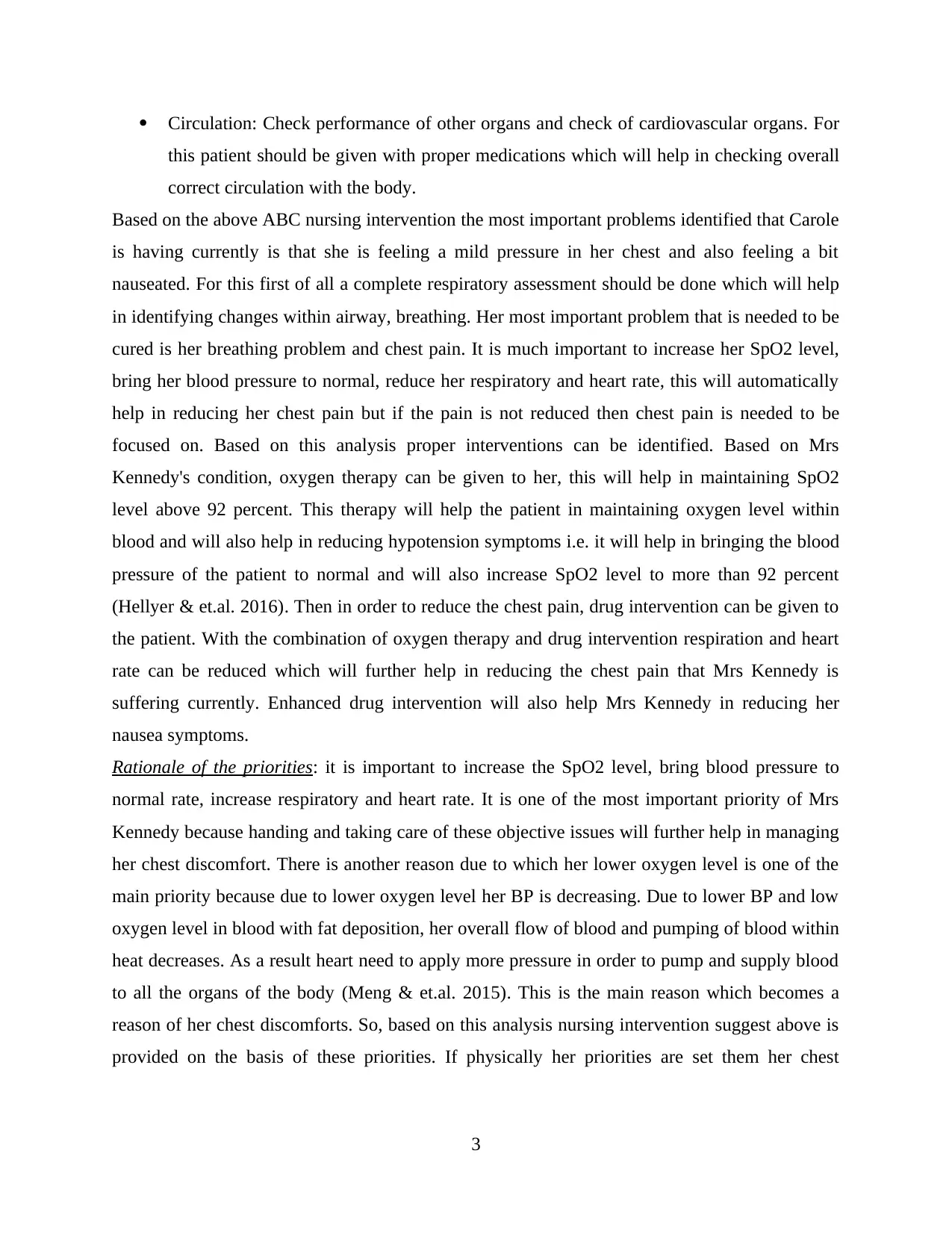
Circulation: Check performance of other organs and check of cardiovascular organs. For
this patient should be given with proper medications which will help in checking overall
correct circulation with the body.
Based on the above ABC nursing intervention the most important problems identified that Carole
is having currently is that she is feeling a mild pressure in her chest and also feeling a bit
nauseated. For this first of all a complete respiratory assessment should be done which will help
in identifying changes within airway, breathing. Her most important problem that is needed to be
cured is her breathing problem and chest pain. It is much important to increase her SpO2 level,
bring her blood pressure to normal, reduce her respiratory and heart rate, this will automatically
help in reducing her chest pain but if the pain is not reduced then chest pain is needed to be
focused on. Based on this analysis proper interventions can be identified. Based on Mrs
Kennedy's condition, oxygen therapy can be given to her, this will help in maintaining SpO2
level above 92 percent. This therapy will help the patient in maintaining oxygen level within
blood and will also help in reducing hypotension symptoms i.e. it will help in bringing the blood
pressure of the patient to normal and will also increase SpO2 level to more than 92 percent
(Hellyer & et.al. 2016). Then in order to reduce the chest pain, drug intervention can be given to
the patient. With the combination of oxygen therapy and drug intervention respiration and heart
rate can be reduced which will further help in reducing the chest pain that Mrs Kennedy is
suffering currently. Enhanced drug intervention will also help Mrs Kennedy in reducing her
nausea symptoms.
Rationale of the priorities: it is important to increase the SpO2 level, bring blood pressure to
normal rate, increase respiratory and heart rate. It is one of the most important priority of Mrs
Kennedy because handing and taking care of these objective issues will further help in managing
her chest discomfort. There is another reason due to which her lower oxygen level is one of the
main priority because due to lower oxygen level her BP is decreasing. Due to lower BP and low
oxygen level in blood with fat deposition, her overall flow of blood and pumping of blood within
heat decreases. As a result heart need to apply more pressure in order to pump and supply blood
to all the organs of the body (Meng & et.al. 2015). This is the main reason which becomes a
reason of her chest discomforts. So, based on this analysis nursing intervention suggest above is
provided on the basis of these priorities. If physically her priorities are set them her chest
3
this patient should be given with proper medications which will help in checking overall
correct circulation with the body.
Based on the above ABC nursing intervention the most important problems identified that Carole
is having currently is that she is feeling a mild pressure in her chest and also feeling a bit
nauseated. For this first of all a complete respiratory assessment should be done which will help
in identifying changes within airway, breathing. Her most important problem that is needed to be
cured is her breathing problem and chest pain. It is much important to increase her SpO2 level,
bring her blood pressure to normal, reduce her respiratory and heart rate, this will automatically
help in reducing her chest pain but if the pain is not reduced then chest pain is needed to be
focused on. Based on this analysis proper interventions can be identified. Based on Mrs
Kennedy's condition, oxygen therapy can be given to her, this will help in maintaining SpO2
level above 92 percent. This therapy will help the patient in maintaining oxygen level within
blood and will also help in reducing hypotension symptoms i.e. it will help in bringing the blood
pressure of the patient to normal and will also increase SpO2 level to more than 92 percent
(Hellyer & et.al. 2016). Then in order to reduce the chest pain, drug intervention can be given to
the patient. With the combination of oxygen therapy and drug intervention respiration and heart
rate can be reduced which will further help in reducing the chest pain that Mrs Kennedy is
suffering currently. Enhanced drug intervention will also help Mrs Kennedy in reducing her
nausea symptoms.
Rationale of the priorities: it is important to increase the SpO2 level, bring blood pressure to
normal rate, increase respiratory and heart rate. It is one of the most important priority of Mrs
Kennedy because handing and taking care of these objective issues will further help in managing
her chest discomfort. There is another reason due to which her lower oxygen level is one of the
main priority because due to lower oxygen level her BP is decreasing. Due to lower BP and low
oxygen level in blood with fat deposition, her overall flow of blood and pumping of blood within
heat decreases. As a result heart need to apply more pressure in order to pump and supply blood
to all the organs of the body (Meng & et.al. 2015). This is the main reason which becomes a
reason of her chest discomforts. So, based on this analysis nursing intervention suggest above is
provided on the basis of these priorities. If physically her priorities are set them her chest
3
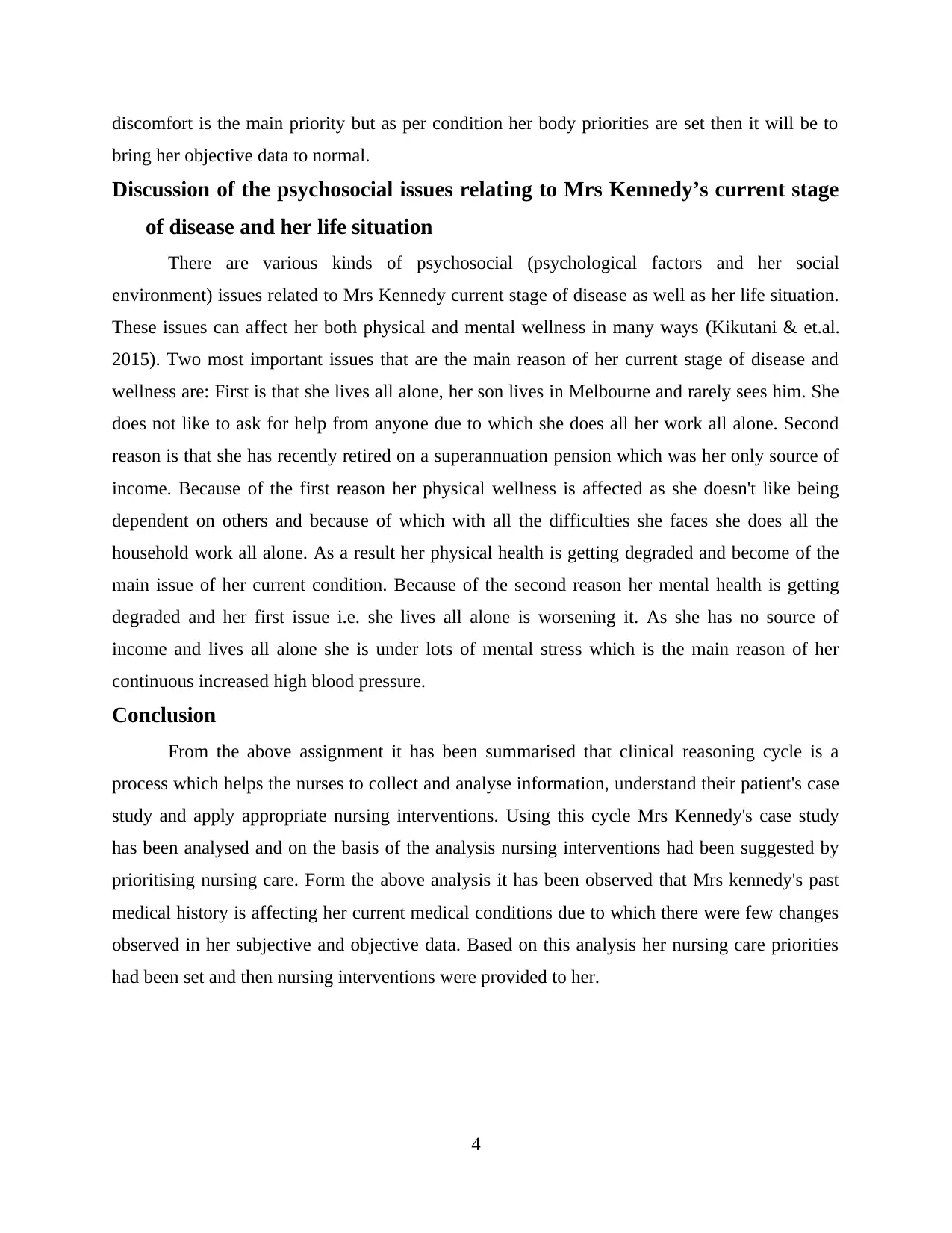
discomfort is the main priority but as per condition her body priorities are set then it will be to
bring her objective data to normal.
Discussion of the psychosocial issues relating to Mrs Kennedy’s current stage
of disease and her life situation
There are various kinds of psychosocial (psychological factors and her social
environment) issues related to Mrs Kennedy current stage of disease as well as her life situation.
These issues can affect her both physical and mental wellness in many ways (Kikutani & et.al.
2015). Two most important issues that are the main reason of her current stage of disease and
wellness are: First is that she lives all alone, her son lives in Melbourne and rarely sees him. She
does not like to ask for help from anyone due to which she does all her work all alone. Second
reason is that she has recently retired on a superannuation pension which was her only source of
income. Because of the first reason her physical wellness is affected as she doesn't like being
dependent on others and because of which with all the difficulties she faces she does all the
household work all alone. As a result her physical health is getting degraded and become of the
main issue of her current condition. Because of the second reason her mental health is getting
degraded and her first issue i.e. she lives all alone is worsening it. As she has no source of
income and lives all alone she is under lots of mental stress which is the main reason of her
continuous increased high blood pressure.
Conclusion
From the above assignment it has been summarised that clinical reasoning cycle is a
process which helps the nurses to collect and analyse information, understand their patient's case
study and apply appropriate nursing interventions. Using this cycle Mrs Kennedy's case study
has been analysed and on the basis of the analysis nursing interventions had been suggested by
prioritising nursing care. Form the above analysis it has been observed that Mrs kennedy's past
medical history is affecting her current medical conditions due to which there were few changes
observed in her subjective and objective data. Based on this analysis her nursing care priorities
had been set and then nursing interventions were provided to her.
4
bring her objective data to normal.
Discussion of the psychosocial issues relating to Mrs Kennedy’s current stage
of disease and her life situation
There are various kinds of psychosocial (psychological factors and her social
environment) issues related to Mrs Kennedy current stage of disease as well as her life situation.
These issues can affect her both physical and mental wellness in many ways (Kikutani & et.al.
2015). Two most important issues that are the main reason of her current stage of disease and
wellness are: First is that she lives all alone, her son lives in Melbourne and rarely sees him. She
does not like to ask for help from anyone due to which she does all her work all alone. Second
reason is that she has recently retired on a superannuation pension which was her only source of
income. Because of the first reason her physical wellness is affected as she doesn't like being
dependent on others and because of which with all the difficulties she faces she does all the
household work all alone. As a result her physical health is getting degraded and become of the
main issue of her current condition. Because of the second reason her mental health is getting
degraded and her first issue i.e. she lives all alone is worsening it. As she has no source of
income and lives all alone she is under lots of mental stress which is the main reason of her
continuous increased high blood pressure.
Conclusion
From the above assignment it has been summarised that clinical reasoning cycle is a
process which helps the nurses to collect and analyse information, understand their patient's case
study and apply appropriate nursing interventions. Using this cycle Mrs Kennedy's case study
has been analysed and on the basis of the analysis nursing interventions had been suggested by
prioritising nursing care. Form the above analysis it has been observed that Mrs kennedy's past
medical history is affecting her current medical conditions due to which there were few changes
observed in her subjective and objective data. Based on this analysis her nursing care priorities
had been set and then nursing interventions were provided to her.
4
⊘ This is a preview!⊘
Do you want full access?
Subscribe today to unlock all pages.

Trusted by 1+ million students worldwide
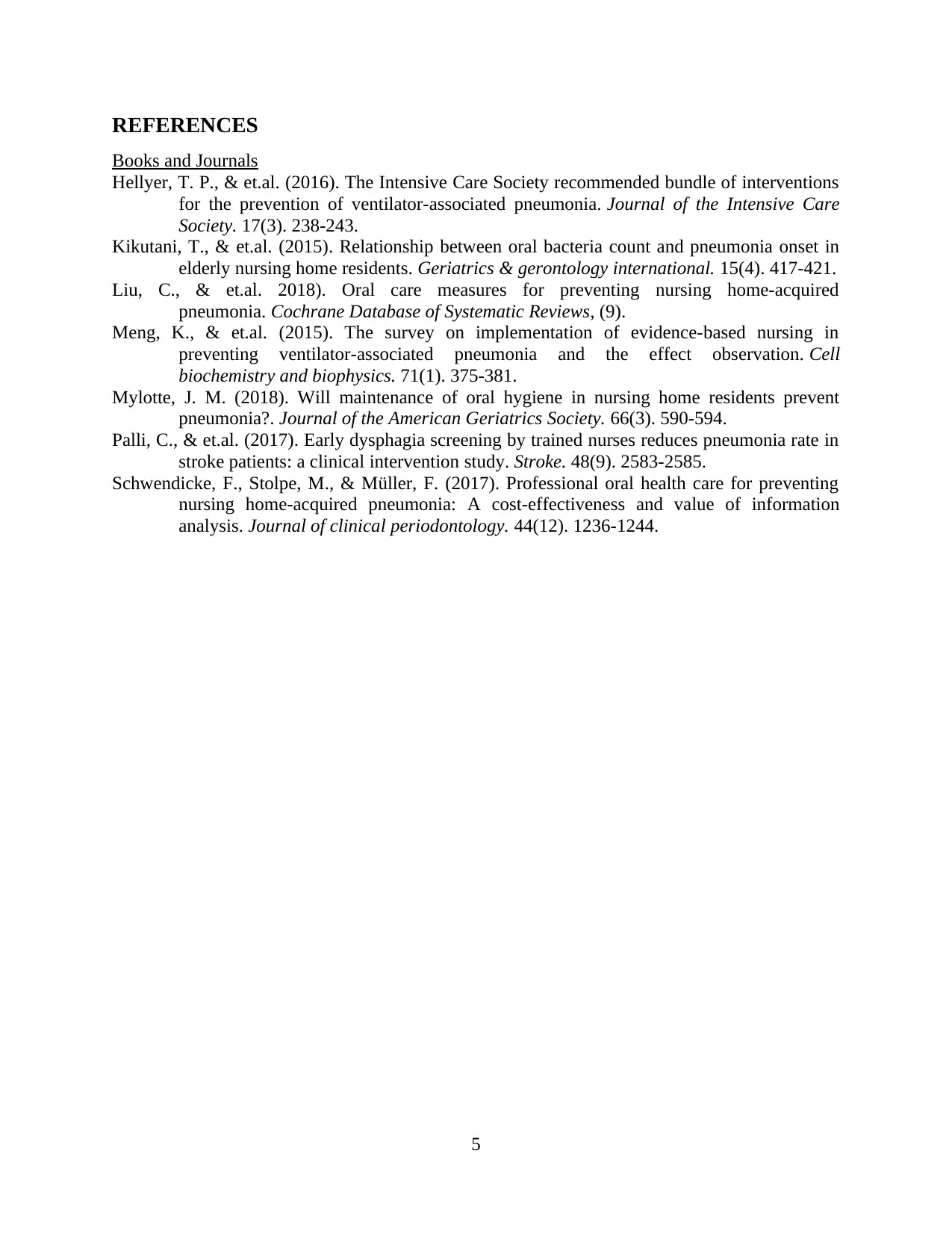
REFERENCES
Books and Journals
Hellyer, T. P., & et.al. (2016). The Intensive Care Society recommended bundle of interventions
for the prevention of ventilator-associated pneumonia. Journal of the Intensive Care
Society. 17(3). 238-243.
Kikutani, T., & et.al. (2015). Relationship between oral bacteria count and pneumonia onset in
elderly nursing home residents. Geriatrics & gerontology international. 15(4). 417-421.
Liu, C., & et.al. 2018). Oral care measures for preventing nursing home‐acquired
pneumonia. Cochrane Database of Systematic Reviews, (9).
Meng, K., & et.al. (2015). The survey on implementation of evidence-based nursing in
preventing ventilator-associated pneumonia and the effect observation. Cell
biochemistry and biophysics. 71(1). 375-381.
Mylotte, J. M. (2018). Will maintenance of oral hygiene in nursing home residents prevent
pneumonia?. Journal of the American Geriatrics Society. 66(3). 590-594.
Palli, C., & et.al. (2017). Early dysphagia screening by trained nurses reduces pneumonia rate in
stroke patients: a clinical intervention study. Stroke. 48(9). 2583-2585.
Schwendicke, F., Stolpe, M., & Müller, F. (2017). Professional oral health care for preventing
nursing home‐acquired pneumonia: A cost‐effectiveness and value of information
analysis. Journal of clinical periodontology. 44(12). 1236-1244.
5
Books and Journals
Hellyer, T. P., & et.al. (2016). The Intensive Care Society recommended bundle of interventions
for the prevention of ventilator-associated pneumonia. Journal of the Intensive Care
Society. 17(3). 238-243.
Kikutani, T., & et.al. (2015). Relationship between oral bacteria count and pneumonia onset in
elderly nursing home residents. Geriatrics & gerontology international. 15(4). 417-421.
Liu, C., & et.al. 2018). Oral care measures for preventing nursing home‐acquired
pneumonia. Cochrane Database of Systematic Reviews, (9).
Meng, K., & et.al. (2015). The survey on implementation of evidence-based nursing in
preventing ventilator-associated pneumonia and the effect observation. Cell
biochemistry and biophysics. 71(1). 375-381.
Mylotte, J. M. (2018). Will maintenance of oral hygiene in nursing home residents prevent
pneumonia?. Journal of the American Geriatrics Society. 66(3). 590-594.
Palli, C., & et.al. (2017). Early dysphagia screening by trained nurses reduces pneumonia rate in
stroke patients: a clinical intervention study. Stroke. 48(9). 2583-2585.
Schwendicke, F., Stolpe, M., & Müller, F. (2017). Professional oral health care for preventing
nursing home‐acquired pneumonia: A cost‐effectiveness and value of information
analysis. Journal of clinical periodontology. 44(12). 1236-1244.
5
1 out of 7
Related Documents
Your All-in-One AI-Powered Toolkit for Academic Success.
+13062052269
info@desklib.com
Available 24*7 on WhatsApp / Email
![[object Object]](/_next/static/media/star-bottom.7253800d.svg)
Unlock your academic potential
Copyright © 2020–2025 A2Z Services. All Rights Reserved. Developed and managed by ZUCOL.




